This is part two of Edward Unthank’s series on building your MOPs team. If you missed part one, read it here.
At what point does your top MOPs person start hunting for a new job? And why? That’s one of thousands of questions my team has encountered over six years of implementing software and strategy for companies in tens of verticals. What I’ve learned is this: There’s a lot more to marketing technology than just technology, and your MOPs person begins looking sooner than you think.
In this post, I’ll share my template for building a sustainable, high-performing marketing operation in the real world, as well as my philosophy based on these past six years.
Plan for people
Most of the articles and advice in MarTech concern software stacks. My philosophy is that people and how you organize your team matters more.
Your designers, strategists, developers, and managers are humans with hopes and aspirations who are motivated by more than salary. Your success with software is a function of your success with them. To keep team members engaged, productive, and growing, you have to consider how your team structure helps or hinders them personally.
For example, does your hierarchy:
- Make people feel valued?
- Enforce the perception of pay parity?
- Allow them to build expertise?
- Incentivize cooperation?
- Encourage trust in the leadership?
On top of that, you have to make sure leadership’s guidance is useful to technical teams.
I call this the Escher question: Does the sort of business logic that wins applause at MarTech conferences (“treat people like people,” “right message, right time”) actually translate into technical logic that you can use in your marketing automation platform? Or is it a beautiful staircase that, to an architect, is schematic nonsense?
Does your business logic translate into operational logic? Or does it sound smart but turn out to be nonsense?

Many a campaign was wrecked on the shore of its own smart rules because leadership didn’t know how the system worked, and they lost more than leads. When the strategy didn’t translate, they lost their team’s trust.
High-functioning teams tend to fix these problems by following two principles:
- Involve technologists in strategy
- Encourage specialization
Both are crucial. Technical people need a seat at the strategy table so that when dreams and reality diverge, they can help talk it out. If there’s an easier way to do something, they’ll help you find it. If something is technically infeasible, you’ll know right away.
And when you encourage specialization, you unlock economies of scale. Just as you wouldn’t tell a team of mechanics to each build their own car, you shouldn’t ask a team of all MOPs generalists to each build their own marketing automation instance. It’s only when individuals focus their full energy on one piece of the process that they learn the 10x productivity tricks. And together, the team builds cars 10x faster.
Specialization also promotes harmony and diffuses team tensions, as we’ll see in a moment.
Templates based on team size
That brings us to team templates. You can build technical input and specialization into your marketing operations by dividing the team into four pillars:
The 4 Pillars of Marketing Operations
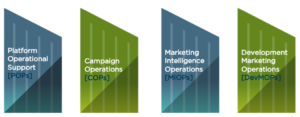

At large enterprises, these are actual titles you can use. At startups, these are responsibilities, or hats, that are handed out as the team grows. Let’s walk through how your team should be organized at each size.
A starter team of 1-2
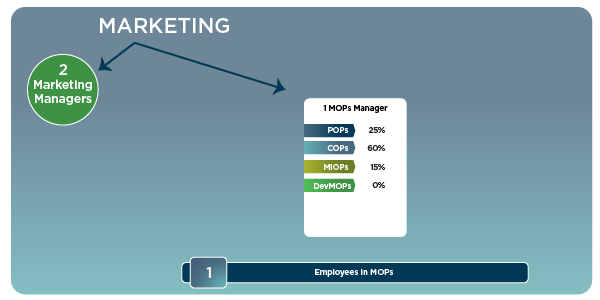
The only time you can get away with a team of all MOPs generalists is when it’s just one or two people. As it grows, each member needs to adopt different and complementary responsibilities or you fall into the “junior work” trap, which goes like this.
When everyone on the team is MOPs, your hierarchy is linear, and everyone wants to avoid doing what’s considered junior work. Nevermind that that work, such as setting up campaigns, might be extremely important, demanding, and best completed by an expert.
If the junior people on your team spend all of their time doing so-called junior work, they feel belittled and start hunting for a new job. If you distribute the work, and senior people spend even 20 percent of their week on work that they perceive to be beneath them, they feel undervalued and they’ll hunt for jobs too. You can’t win.
But if you divide work into the above four pillars, with people who are equals across the hierarchy, you remove the “junior work” paradigm and each function gets the attention and care it deserves.
A small team of 3-4
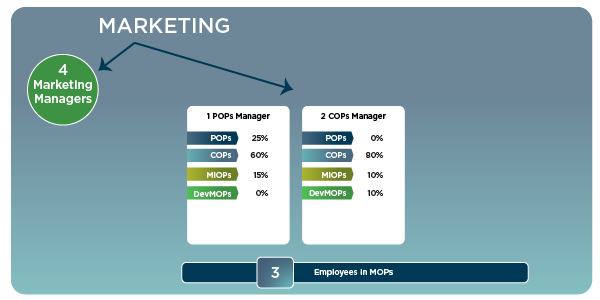
Your next few hires should be to COPs. One MOPs manager owns the platform and manages COPs specialists whose breakdown of responsibilities remain the same, but who handle the increasing amount of work.
A medium team of 5-7
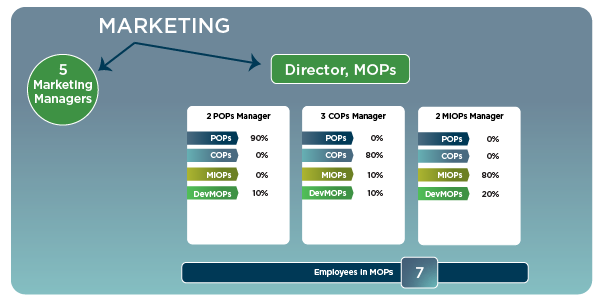
When your team grows to five to seven people, it’s time to promote or hire a director of marketing operations and to divide out COPs, POPs, and MIOPs roles into their own teams.
Why do campaigns deserve their own team? Because there’s a lot more to doing them well than people commonly think. Running ongoing challenger champion testing methodology requires an understanding of statistics, probability, and human nature that’s so much more than just a “Hey, can you schedule this email for me?” sort of job.
Separate pillars create paths to promotion that reward specialists for their knowledge
Separate pillars also create paths to promotion that reward specialists for their knowledge. In the generalist model, the only way a person can earn a promotion is to move into platform operations, which is to say, to learn something new which they may not be inclined toward. In the specialization model, people are rewarded for their continued passion.
Plus, if everyone is a generalist, nobody acquires the deep domain expertise needed to avoid death by a thousand paper cuts. When the rest of the organization has questions like “Why did this one lead not get through this queue?” you need answers, or your generalists will spend all their time handling edge cases.
A large team of 10+
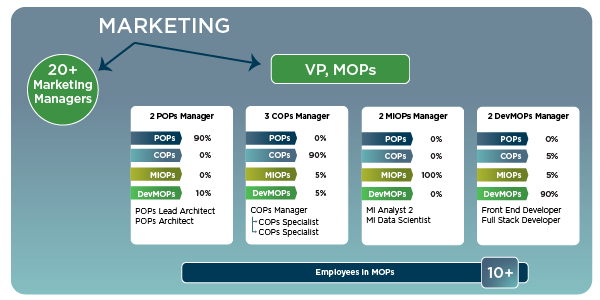
At a team of 10, it’s time for a VP of marketing operations, because you need some senior representation on the buying committee when choosing tools, and for DevMOPs, because your tech stack is large, complex, and probably requires custom code. Each area has representation, the freedom to specialize, and a path to promotion, so they can grow within the organization.
Now that you have the foundation of each team in place, you can easily scale up and down. Each team gets its own focus areas and specialty. You don’t have junior people doing senior tasks, or senior people doing any more than 20 percent of what might be considered junior tasks. You have a team of people who are happy with their specialized day-to-day, with their own challenges and areas of growth and improvement.
Your turn
How do these four pillars reflect your marketing operations team today? Do they influence your plans for tomorrow? From everything we’ve learned at Etumos, this structure is key to building a high-performing marketing operation in the real world, not just on paper.
Technology matters a lot. But people matter more. If you plan for people from the beginning, you’ll be able to implement the sorts of strategies that win applause at MarTech conferences. But unlike many peers, you’ll actually make them work.
Have feedback and thoughts? Let’s connect on Twitter.







